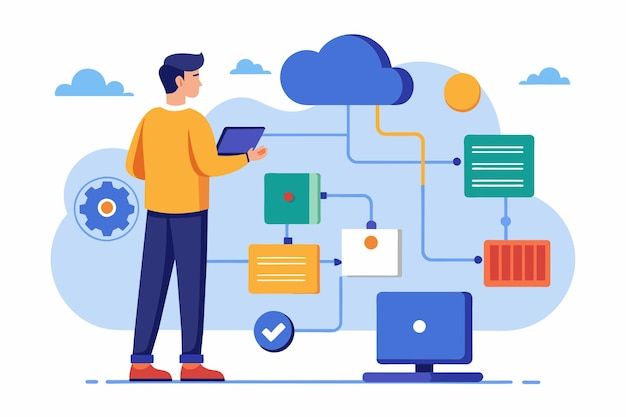In the rapidly evolving landscape of higher education, cloud-based technologies are revolutionizing how institutions operate and deliver learning experiences. As we navigate through 2025, virtual campuses have become more than just a temporary solution; they represent a fundamental shift toward flexible, accessible, and efficient educational models.
Cloud tools, ranging from storage solutions to collaborative platforms, are at the heart of this transformation, enabling seamless integration of digital resources and supporting a global student body. This article explores the profound impact of these technologies, highlighting their benefits, key applications, emerging trends, potential hurdles, and future prospects.
By leveraging cloud infrastructure, educational institutions can create dynamic virtual environments that enhance teaching, learning, and administration, ultimately preparing students for a digital-first world.
The Rise of Virtual Campuses in Modern Education
Virtual campuses emerged as a necessity during global disruptions like the COVID-19 pandemic, but in 2025, they have solidified their place as essential components of educational strategies. These digital ecosystems allow universities and colleges to extend their reach beyond physical boundaries, offering courses, resources, and interactions online.
Cloud tools serve as the backbone, providing the infrastructure needed to host vast amounts of data, facilitate real-time collaboration, and ensure uninterrupted access.
One of the primary drivers behind this adoption is the demand for hybrid learning models, where students can blend in-person and online experiences. According to industry insights, the integration of cloud solutions has led to a significant increase in enrollment for online programs, as institutions can now cater to diverse learners, including working professionals and international students. This flexibility not only boosts accessibility but also aligns with the growing emphasis on lifelong learning, where individuals can upskill at their own pace.
Moreover, cloud technologies address the limitations of traditional on-campus setups, such as high maintenance costs for hardware and restricted scalability. By migrating to the cloud, schools can dynamically allocate resources, ensuring that virtual campuses remain responsive to fluctuating demands, like peak enrollment periods or sudden shifts to remote learning.
Benefits of Cloud Tools for Virtual Campuses
The advantages of incorporating cloud tools into virtual campuses are multifaceted, impacting students, educators, and administrators alike. Here, we delve into the core benefits that make these technologies indispensable in 2025’s educational environment.
A. Cost Efficiency and Predictable Budgeting Cloud solutions eliminate the need for extensive on-site infrastructure, reducing capital expenditures on servers, storage, and maintenance. Institutions pay only for the resources they use, leading to predictable operational costs.
For instance, managed cloud services allow schools to avoid the financial burden of outdated hardware upgrades, freeing up budgets for innovative programs. This cost-saving aspect is particularly beneficial for smaller colleges or those in developing regions, enabling them to compete with larger universities by offering high-quality virtual experiences without breaking the bank.
B. Scalability for Growing Demands Virtual campuses must handle varying loads, from a handful of users during off-peak hours to thousands during exams or live sessions. Cloud tools provide elastic scalability, automatically adjusting resources to meet these needs.
This ensures smooth performance, preventing downtime that could disrupt learning. In 2025, with the rise of massive open online courses (MOOCs), this feature has become crucial, allowing institutions to expand their virtual offerings globally without proportional increases in IT staff or equipment.
C. Enhanced Accessibility and Inclusivity Cloud platforms make education available anytime, anywhere, breaking down geographical and temporal barriers.
Students with disabilities or those in remote areas can access materials through adaptive interfaces, while real-time translation features support multilingual environments. This inclusivity fosters a more diverse student population, enriching virtual campus discussions and collaborations.
D. Improved Collaboration and Engagement Tools integrated into cloud systems enable seamless teamwork, with features like shared documents, video conferencing, and interactive whiteboards. Educators can create engaging virtual classrooms where students participate actively, regardless of location. This has led to higher retention rates in online programs, as interactive elements mimic the dynamism of physical campuses.
E. Robust Data Management and Analytics Cloud tools offer advanced analytics to track student progress, identify at-risk learners, and personalize instruction. Real-time data insights help administrators optimize virtual campus operations, from course design to resource allocation. This data-driven approach enhances educational outcomes and supports evidence-based decision-making.
F. Environmental Sustainability By reducing the reliance on physical servers, cloud adoption minimizes energy consumption and electronic waste. Institutions committed to green initiatives find cloud tools align with their goals, contributing to sustainable virtual campuses that appeal to eco-conscious students and stakeholders.
These benefits collectively empower virtual campuses to deliver high-quality education efficiently, making cloud tools a strategic investment for long-term success.
Key Cloud Tools and Platforms Transforming Education
A variety of cloud-based tools and platforms are driving the empowerment of virtual campuses. These solutions range from general-purpose providers to education-specific applications, each offering unique features tailored to learning needs.
A. Microsoft Azure and Office 365 Azure provides scalable computing power for hosting virtual labs and simulations, while Office 365 integrates tools like Teams for collaborative classrooms. Universities use these for hybrid setups, where students access lectures and assignments seamlessly. In 2025, Azure’s AI integrations enhance personalized learning paths in virtual environments.
B. Amazon Web Services (AWS) AWS offers robust storage and machine learning capabilities, ideal for data-intensive virtual campuses. Tools like AWS Educate provide free credits for students, fostering hands-on experience in cloud computing. This platform supports massive scalability for online degree programs.
C. Google Cloud and Workspace Google’s suite, including Drive and Classroom, facilitates file sharing and assignment management. Its cloud infrastructure powers VR/AR experiences, immersing students in virtual field trips or simulations. Workspace’s integration with analytics tools helps track engagement in virtual sessions.
D. AppsAnywhere and Similar Delivery Platforms Specialized tools like AppsAnywhere allow on-demand access to software applications via the cloud, eliminating the need for high-end devices. This is particularly useful for STEM fields, where students run complex programs remotely.
E. Learning Management Systems (LMS) like Canvas and Blackboard These cloud-hosted LMS platforms centralize course content, assessments, and communications. They integrate with other tools for a unified virtual campus experience, supporting features like gamification and mobile access.
F. Managed Cloud Services from Providers like ComsolTX These services handle migration and maintenance, ensuring secure, customized environments. They include cybersecurity features and compliance tools, vital for protecting student data in virtual setups.
G. Analytics Tools such as Google Analytics for Education These provide insights into user behavior, helping refine virtual campus designs. They track metrics like session duration and completion rates to improve content delivery.
By selecting the right combination of these tools, institutions can build resilient virtual campuses that adapt to evolving educational demands.
Emerging Trends in Cloud Tools for 2025
As we look at 2025, several trends are shaping how cloud tools continue to empower virtual campuses, driven by technological advancements and shifting learner expectations.
A. Integration of AI and Machine Learning Cloud platforms are increasingly embedding AI for adaptive learning, where algorithms tailor content to individual needs. This trend enhances virtual tutoring and predictive analytics, forecasting student success.
B. Hybrid and Multi-Cloud Strategies Institutions are adopting multi-cloud approaches to avoid vendor lock-in and optimize performance. This allows seamless switching between providers for better reliability in virtual operations.
C. Focus on Cybersecurity and Privacy With rising cyber threats, cloud tools are prioritizing advanced encryption and compliance features. In 2025, expect more emphasis on zero-trust models to safeguard virtual campuses.
D. Immersive Technologies like VR/AR Cloud-powered VR/AR is creating interactive virtual worlds for subjects like history or medicine, making learning experiential and engaging.
E. Edge Computing for Low-Latency Experiences To support real-time interactions in virtual campuses, edge computing reduces delays, ideal for live collaborations or simulations.
F. Sustainability-Focused Cloud Solutions Providers are offering green cloud options, using renewable energy sources to appeal to environmentally aware institutions.
G. Blockchain for Credentialing Cloud-integrated blockchain ensures secure, verifiable digital credentials, streamlining verification in virtual learning paths.
These trends indicate a future where cloud tools not only support but actively innovate virtual campus experiences.
Challenges in Implementing Cloud Tools and Solutions
Despite the advantages, adopting cloud tools for virtual campuses comes with hurdles that institutions must address.
A. Data Security and Privacy Concerns The education sector has seen a surge in cyberattacks, raising worries about student data protection. Solutions include partnering with managed providers for robust security protocols.
B. Integration with Legacy Systems Many schools struggle to migrate from outdated infrastructure. Gradual hybrid implementations and expert consultations can ease this transition.
C. Digital Divide and Accessibility Issues Not all students have reliable internet or devices. Institutions can mitigate this by offering subsidies or offline-capable features.
D. Training and Adoption Barriers Faculty may resist change due to unfamiliarity. Comprehensive training programs and user-friendly interfaces are key solutions.
E. Cost Management in Scaling While cost-effective, unexpected usage spikes can inflate bills. Analytics tools help monitor and optimize spending.
F. Regulatory Compliance Ensuring adherence to laws like FERPA requires cloud providers with built-in compliance features.
By proactively tackling these challenges, virtual campuses can fully harness cloud potential.
Case Studies: Real-World Applications
Several institutions exemplify successful cloud adoption in virtual campuses.
A. University of Texas Permian Basin This university leverages cloud computing to enhance online programs, reducing costs and improving collaboration, leading to higher student satisfaction.
B. A Hypothetical Midwestern College Using AWS and Canvas, this college scaled its virtual offerings during enrollment surges, maintaining performance without additional hardware.
C. Global Online University Network Integrating Azure and AI tools, this network personalized learning for thousands, boosting completion rates by 20%.
D. European Tech Institute Adopting AppsAnywhere, the institute provided remote access to specialized software, enabling international students to participate fully.
These examples demonstrate tangible outcomes from cloud empowerment.
Future Outlook for Cloud-Empowered Virtual Campuses
Looking beyond 2025, cloud tools will likely incorporate quantum computing for complex simulations and deeper AI integrations for hyper-personalized education. As 6G networks emerge, virtual campuses could offer ultra-immersive experiences, blurring lines between physical and digital realms. Institutions that invest now will lead in this digital era, fostering innovation and equity in education.
Conclusion
Cloud tools are undeniably empowering virtual campuses, offering scalability, efficiency, and innovation that redefine education in 2025. From cost savings to enhanced engagement, these technologies address modern challenges while opening new opportunities. As institutions continue to adopt and refine these solutions, the future of learning looks brighter, more inclusive, and infinitely adaptable.














